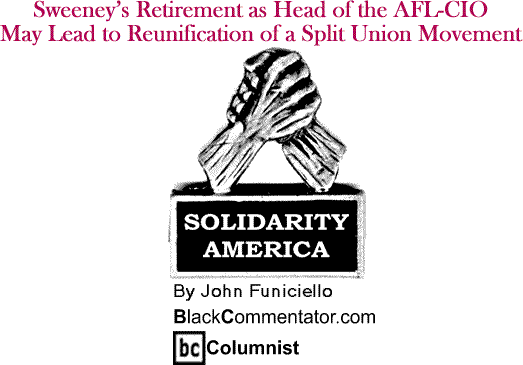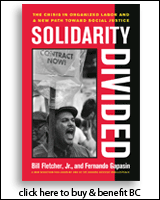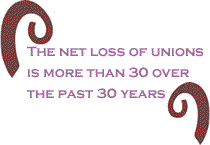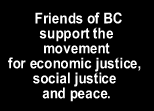
|
|||||||||||||||||||||||

|
|

Custom Search
|
|
 |
|
Organized
labor in Since
the withdrawal of seven of the federation’s unions and the formation
of Change to Win (CtW), a rival federation, about five years ago,
the organized labor movement in the The result has been that union jobs have been cut and slashed on an unprecedented scale, and the prospects of recovery of the well-paying jobs that have been lost by the millions - such as in auto, steel, glass, rubber, heavy equipment, and appliances - look dimmer every day. Most labor historians, old trade unionists, and candid economists know that the demise of the strength of unionized labor translates inevitably into the demise of good times for all American workers. And that would be most Americans who work for a paycheck, whether their annual income is $40,000 or $200,000. That range might seem to be rather wide, but, given life styles of the households which earn that kind of money, it would not take the loss of too many of those paychecks to see the loss as well of the house, the second car, the vacation home, the vacation, and other amenities of what is generally called “middle class” life. The reality is that the $40,000 annual earner knows he is in the working class, while the $200,000 annual earner would consider herself to be solidly in the middle class.
It’s not easy to get exact numbers, but organized labor was reduced to the old federation, the AFL-CIO, with about 8-9 million, and CtW with 5-6 million. CtW leaders, as they headed out the door, said they were leaving because the AFL-CIO under Sweeney, formerly the president of Service Employees International Union (SEIU), was not doing anywhere near enough to organize new workers. They wanted more action and greater vitality in organizing and didn’t see any prospect of that under Sweeney’s leadership. The AFL-CIO planned to continue its political action and legislative activity on behalf of working people, while CtW downplayed the need for such entrenched involvement in the electoral process and saw its power in organizing in the street and in the workplaces. How they were going to coordinate the two aspects of an organized labor movement, leaders of the split federations never discussed publicly. The split appeared to be a top-down decision, as much of the decision-making in the union movement has been for some decades. As a result, the split was much talk at the national level and a much narrower split at the local level. Some local unions in CtW, in fact, never left the city and county labor federations of the AFL-CIO, participating in political work and other projects, as if the split never occurred.
There was cooperation in the recent campaign of Barack Obama for the presidency and, even with Obama in the White House, it’s going to be an uphill battle to win passage of the Employee Free Choice Act (EFCA), the card-check law, because the Democrats in the Senate do not have the filibuster-proof 60 votes in favor of EFCA, which the president has said he will sign if it gets to his desk. While Sweeney’s retirement - he’ll be 75 years old next month - gives the major unions an opportunity to negotiate a settlement and re-connect, with an eye toward addressing the problems of American workers in both the electoral process and in the workplaces, a major problem is the loss of union jobs, which means the loss of membership in the federation’s member unions. That means a smaller treasury. Even if the two federations get together, that problem won’t go away, but a united federation gives its member unions a voice in the society at large that they otherwise would not have. The fight for the presidency of the newly-combined joint federation will be of interest and it will be of even greater interest to see if any of the candidates make rank-and-file participation in the union movement one of the top priorities in any campaign. Even with a renewed working relationship - and, possibly, solidarity? - among the biggest and most powerful national unions, any reconstituted federation is bound to be short a few unions. That’s because there are internal differences and battles in individual unions that will not be resolved by the joining of the AFL-CIO and CtW. In
1980, there were more than 90 unions affiliated with the AFL-CIO.
There are now 56 unions. CtW has seven unions. Whatever form the new federation takes, union officials need to recognize that passage of EFCA will not be the end-all solution to the demise of worker power. Involvement in electoral politics can only take the union movement part of the way. Aggressive organizing can only take the movement so far. An educated and motivated rank-and-file is the answer to the decline in organized labor’s power in the nation and its economy. They’re not going to get that education and motivation from their schools or mass media. That’s the job of the new federation. BlackCommentator.com Columnist, John Funiciello, is a labor organizer
and former union organizer. His union work started when he became
a local president of The Newspaper Guild in the early 1970s. He
was a reporter for 14 years for newspapers in |
|
Any BlackCommentator.com article may be re-printed so long as it is re-printed in its entirety and full credit given to the author and www.BlackCommentator.com. If the re-print is on the Internet we additionally request a link back to the original piece on our Website. Your comments are always welcome. eMail re-print notice
If you send us an eMail message we may publish all or part of it, unless you tell us it is not for publication. You may also request that we withhold your name. Thank you very much for your readership. |
|
| |
|
| April 30 , 2009 Issue 322 |
|
| Executive Editor: Bill Fletcher, Jr. |
| Managing Editor: Nancy Littlefield |
| Publisher: Peter Gamble |
| Est. April 5, 2002 |
Printer Friendly Version
in resizeable plain
text format or pdf
format. |
| Frequently Asked Questions |
 |

|
 |
 |
 |
| |
| |





























 CtW
appeared to leave the electoral work to the AFL-CIO, but it became
clear to them that only concentrating on organizing was not going
to produce a successful and dynamic separate labor federation, because,
no matter how successful unions are at organizing, a hostile majority
in Congress and hostile majorities in state legislatures can take
it all away with laws. They have to do both.
CtW
appeared to leave the electoral work to the AFL-CIO, but it became
clear to them that only concentrating on organizing was not going
to produce a successful and dynamic separate labor federation, because,
no matter how successful unions are at organizing, a hostile majority
in Congress and hostile majorities in state legislatures can take
it all away with laws. They have to do both. The
net loss of unions is more than 30 over the past 30 years, and the
drain of union members in those unions continues, because of industry
shut-downs and capital flight to low-wage countries.
The
net loss of unions is more than 30 over the past 30 years, and the
drain of union members in those unions continues, because of industry
shut-downs and capital flight to low-wage countries.






